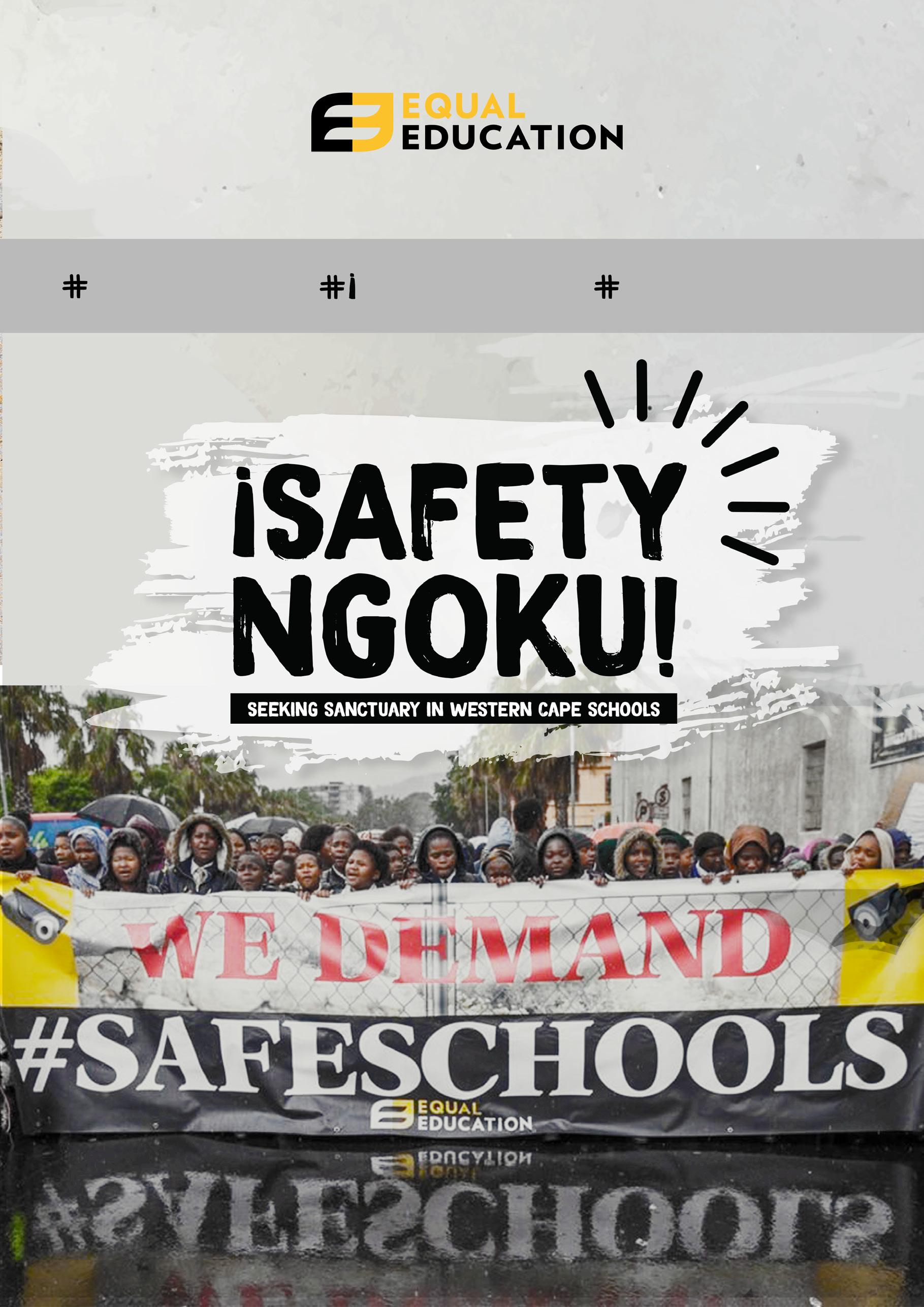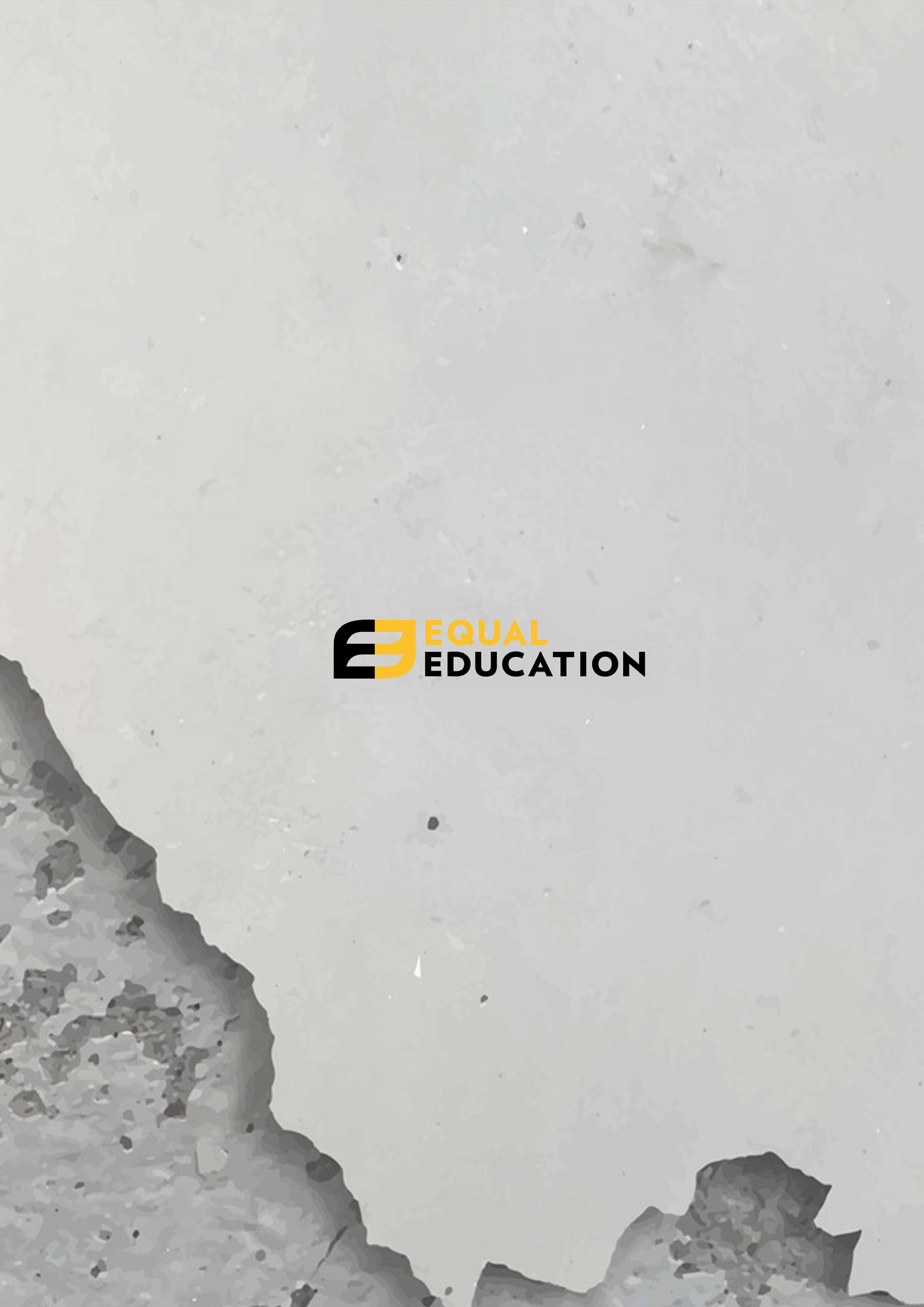

A CAMPAIGN IS BORN: EQUAL EDUCATION AND THE STRUGGLE FOR SAFE SCHOOLS
In 2014, Equalisers in the Western Cape identified school safety as one of the biggest challenges to fully realising their right to basic education. Many of these Equalisers live and attend school in under-resourced communities on the outskirts of Cape Town, where poverty, unemployment, gang activity, and drug use are common.
For instance, official crime statistics often show that various communities in the province are hotspots for violence and contact crimes like murder, sexual offences, assault with intent to cause grievous bodily harm and common assault, and gangrelated violence
The social issues in these communities, part of the legacy of apartheid, often fuel violent activities that eventually spill into nearby schools, leaving learners and school staff in danger of suffering physical and psychological harm.
Equal Education (EE) is a youth-led mass democratic movement of learners, post-school youth, parents, teachers and community members who use mobilisation and public action, supported by careful research, to empower young activists and ensure equality in South African education.
In 2015, EE conducted a social audit on school safety and sanitation. We surveyed 912 learners in 244 schools across all eight education districts in the Western Cape.
We found:
• many of the learners had either been victims of or witnessed violent incidents, including physical assault, sexual harassment, and corporal punishment;
• many of the schools had inadequate security infrastructure;
• many of the schools had no access control; and
• teachers’ lacked training to ensure learner’s safety in school
Since EE’s social audit was published six years ago, Equalisers have reported that little has changed in terms of their perceptions of safety at school and the conditions that are supposed to be in place to help ensure their safety.
2
EE’S ONGOING PURSUIT OF SAFE SCHOOLS: THE 2019 SCHOOL VISITS AND THE STRUGGLE FOR SAFE SCHOOLS
Given the deep-rooted and persistent safety issues at schools in Cape Town, EE carried out school visits to 40 public schools located in City Bowl, Elsies River, Gugulethu, Khayelitsha, Kraaifontein, Langa, Mfuleni, Mitchells Plain, Nyanga, Philippi, Strand between August and September 2019. We heard directly from principals, deputy principals, and teachers about the safety challenges experienced in their schools.
We found that the most common threats to learners’ safety in schools are drug use (85%), theft of personal property (63%), alcohol use (53%), gang violence (53%), burglary (53%), and significant vandalism (50%), as at least half of the schools identified them among the different types of violence that learners reported. Other reported violence at school includes physical assault resulting in serious injury, stabbings, sexual harassment, physical assault against a teacher by a learner, and physical assault resulting in significant injury to a teacher.
3
DRUG USE GANG VIOLENCE THEFT OF PERSONAL PROPERTY BURGLARY ALCOHOL USE SIGNIFICANT VANDALISM 85% 53% 63% 53% 53% 50%
threats to learners’ safety in schools
Major
From the findings, we identified four safety pillars that can improve existing and prevent potential threats to safety and security in schools:
• Pillar 1: Security measures in line with the school infrastructure law
• Pillar 2: Functional school-based safety structures e.g. school safety committee
• Pillar 3: Adequate provision of psychosocial support

• Pillar 4: Knowledge of and use of existing safety-related policies
PILLAR 1:
The school infrastructure law says that all schools must have security fencing that goes around the entire school that is at least 1.8 meters high and at least one other form of safety and security, such as burglar bars on all opening window sections on ground floor buildings that are used by learners and teachers, a security guard, or an alarm system linked to a rapid armed response. We found that:
• even though all 40 schools had some form of fencing, not all of them were 1.8m high or went around the entire school while others were broken and had holes in them;
• nearly all the schools reported having a security guard, but these were mostly community members or parent volunteers and did not have formal training; and

• In more than half of schools that had an alarm system, these were only installed in administrative blocks, leaving resources in classrooms, libraries and laboratories at risk of being stolen.
NATIONAL SCHOOL SAFETY FRAMEWORK (NSSF)
A national framework by the Department of Basic Education (DBE) that helps safety stakeholders including provincial and district officials, principals, school management, school-governing bodies, teachers, and learners— identify, manage, and address safety challenges and incidents of violence at school.
NORMS AND STANDARDS FOR PUBLIC SCHOOL INFRASTRUCTURE
The Norms and Standards for Public School Infrastructure (“the school infrastructure law”) prescribes the basic level of infrastructure that every school must have in order to function properly and sets out specific timeframes within which this infrastructure must be provided.
4
Security measures in line with the school infrastructure law
The school visits showed us that although there was some form of security measure, schools did not always have enough funding to maintain these systems and to employ trained security guards. This affected access control and meant that schools were at risk of intrusion, vandalism, and damage caused by burglaries.
SAFE SCHOOLS PROGRAMME
PILLAR 2:
Functional school-based safety structure
Schools are expected to have a plan in place to deal with safety-related challenges unique to their community/location and to develop strategies that will help them respond to any immediate safety threats. This also requires schools to establish a school safety committee, appoint a school safety officer, and develop a safety plan. Our findings showed that:
• most (37) of the 40 schools had established a safety committee, but this committee was only functional in 25 of these schools.
• all but two of the schools with safety committees had a safety officer, but safety officers were reportedly actively involved in addressing safety issues at only 28 of these schools.
• 30 of the 40 schools had safety plans. Yet, 12 of the schools with safety plans reported not using them.
A provincial programme by the Western Cape Education Department (WCED) that works with school communities to ensure safe environments for all learners and school staff through improving security infrastructure (e.g. fencing, alarms, safety signs, etc.), changing behaviour through counselling of learners or conflict management, and building relationships and partnerships with other safety stakeholders such as NGOs and communities.
SAFET Y PL AN
5
PILLAR 3:
Adequate provision of psychosocial support
School safety is also affected by the availability and accessibility of adequate psychosocial support to ensure the psychological well-being of learners, especially when learners have experienced or witnessed violence at school. This support is equally important for learners who show behaviours that may disrupt teaching and learning or make it difficult for teachers to discipline learners (e.g. aggression or bullying in class). In this regard, school-based support teams (SBSTs) play a very important role in making sure that learners receive the psychosocial support they need, particularly in instances where there are no trained psychologists or social workers based at the school.
Our school visits found that:
• 30 schools did not have a psychologist or social worker based at the school.
• 30 schools had at least one teacher available to provide initial psychosocial support, but many of these teachers had not received training for this duty or given space in their timetable to to be able to effectively carry out this duty.
• 35 schools had an SBST that ensured that learners who need counselling or psychological support are appropriately referred.

PILLAR 4:
Knowledge of and use of existing safety policies
National policies and interventions such as the National School Safety Framework (NSSF) and the provincial Safe Schools Programme are intended to help school communities and safety stakeholders identify and manage safety challenges and violent incidents at schools. A good awareness of and effective implementation of these safety policies are vital to ensuring learners’ well-being at school.
WHAT IS PSYCHOSOCIAL SUPPORT?
Psychosocial support involves professionals who understand the systems, stress and social problems that cause learners to struggle and find ways to help them work through them. Psychosocial support should be available at the school and district levels and provided by outside organisations trained in the field of professional support services.
6
Our findings showed that:
• 18 schools had no knowledge of the NSSF, while many schools did not have the necessary support, safety structures, and procedures in place to implement it.
• 28 schools reported making use of the call centre, a crucial offering of the Safe Schools Programme, to report safety concerns or violent incidents for the necessary support or referrals. Even though the call center is a helpful intervention, schools had issues with how long it took to get help.
• only 21 of the schools had the call center’s toll-free number visible and accessible on their grounds.
SAFE SCHOOLS CALL CENTRE
The Safe Schools Call Centre was established for learners, teachers, non-teaching staff and parents to report violence, abuse, alcohol and drug abuse, vandalism and any other concerns related to safety. The Safe Schools Call Centre’s telephone number is 0800 45 46 47 and calls to this number are free!

CONCLUSION
The school visits revealed several difficulties that schools encounter in achieving the four safety pillars, including a lack of internal capacity, insufficient funding and resources, and administrative roadblocks. These issues threaten the physical, emotional, and mental health of both learners and teachers, as well as leading to safety threats and violent crimes in schools.

7
The DBE should commission a fully-funded revised round of the National School Violence Study (NSVS survey) to obtain updated information that reflects the current types of violence occurring in schools to better understand and identify context-specific factors that contribute to school safety challenges. The WCED should use this knowledge and its experience to create and rollout social programs and interventions that specifically address the causes of identified violence in schools.
3
The WCED should coordinate with the DBE to ensure urgent and full compliance with the security requirements in the school infrastructure law by:
a. ensuring adequate access control measures are in place to protect school premises and school communities; and
b. urgently assisting high-risk schools with installation or maintenance of physical security infrastructure to protect them from opportunistic crimes such as burglary, vandalism, and trespassing.
The WCED should support schools in establishing functional safety committees in schools by:
a. helping schools identify active safety stakeholders in their school communities to include in their safety committees;
b. providing training sessions for members of the committee that cover their roles and responsibilities, and the development of comprehensive safety plans tailored to their respective contexts; and
c. ensuring that systems are in place to prevent loss of knowledge within the committee, particularly as its composition changes (e.g. record-keeping).
8
RECOMMENDATIONS 1 2
The WCED should assist schools to bolster the provision of and access to psychosocial support services by:
a. ensuring that school-based support teams are trained and capacitated, and that school conditions allow for their role to be accommodated in timetabling;
b. increasing the capacity of professional psychosocial support services through leveraging partnerships with the Departments of Social Development and Health as well as with relevant NGOs; and
c. exploring newer and creative ways to deliver psychosocial support to learners, such as through telephonic and mobile app consultations.
The WCED should improve the knowledge and internal capacity of schools on national and provincial school safety interventions such as the National School Safety Framework (NSSF) and the Safe Schools Programme by:
a. providing regular training on how to implement the NSSF as well as information resources such as available training providers outside of the department;
b. following up with schools that have undergone training to understand and assist them with any challenges they face with implementing the NSSF;
c. assisting schools to increase awareness of the Safe Schools Call Centre among learners through, for example, materials (e.g. pamphlets, presentations in school assemblies) that outline the functions of the call centre and the provision of merchandise (e.g. stationery) with the call centre’s number;
d. monitoring schools to ensure they are providing signage with the call centre’s toll-free number that is visibly displayed at key areas on the school premises; and
e. adequately capacitating the Safe Schools Call Centre to deal with high call volumes and ensure that schools and other callers receive timeous assistance or referrals.
9
4 5
DEFINITIONS
SAFETY OFFICER:
a person appointed by the principal (e.g. a teacher), who is also a member of the school safety committee and helps with putting school safety strategies in place.

SAFETY COMMITTEE:
the school safety committee is made up of different members of the school community, including parents, learners, teachers, principals, SGB, and school management team, SAPS and community organisations responsible for developing and implementing a school safety plan and monitoring safety measures.
SAFETY PLAN:
a school’s plan that clearly outlines its approach to safety issues. The plan should describe the infrastructure that keeps the school safe (e.g. is there appropriate fencing? Is there a working alarm system?), access control issues (e.g. what happens when there is an intruder on school property?), what to do in emergencies (e.g. gang violence or a fire) and any other aspects that may impact or improve safety (e.g. community involvement and partnerships).
SCHOOL-BASED SUPPORT TEAM:
a team made up of a representative of the School Management Team (e.g. deputy principal), a teacher from each grade or phase, a coordinator and a learning support teacher, if the school has one. This team must make sure that learners who need counselling or psychological support are appropriately referred.
10
SAFETY PL AN

SEEKING
SANCTUARY IN WESTERN CAPE SCHOOLS











